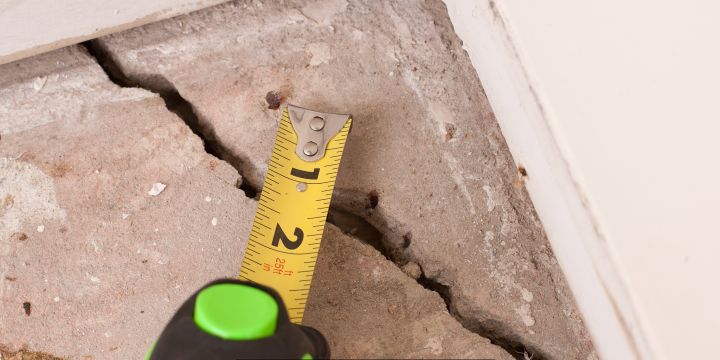Foundation cracks are a common concern for homeowners, often signaling underlying issues that could compromise the structural integrity of a building. These fissures can manifest in various forms, ranging from hairline cracks to more significant gaps that may widen over time. Understanding the basics of foundation cracks is essential for homeowners to recognize potential problems early and take appropriate action.
The foundation serves as the bedrock of a home, supporting its weight and ensuring stability. When cracks appear, they can indicate that the foundation is settling or shifting, which may lead to more severe structural damage if left unaddressed. Cracks can occur in different areas of the foundation, including walls, floors, and even ceilings.
The location and type of crack can provide valuable insights into the nature of the problem. Vertical cracks, for instance, are often a result of normal settling and may not pose a significant threat. In contrast, horizontal cracks can indicate more serious issues, such as soil pressure or water infiltration.
Homeowners should familiarize themselves with these distinctions to better assess the severity of any cracks they encounter.
Key Takeaways
- Foundation cracks can be caused by a variety of factors including settling, soil movement, and water damage.
- Signs of foundation settling include uneven floors, cracked walls, and doors and windows that stick or don’t close properly.
- Common causes of foundation cracks include poor soil compaction, tree roots, and plumbing leaks.
- Ignoring foundation issues can lead to serious structural damage and decrease the value of your home.
- Addressing foundation cracks may involve repairing the cracks, installing drainage systems, and stabilizing the foundation with piers or anchors.
Signs of Foundation Settling
Recognizing the signs of foundation settling is crucial for homeowners who wish to maintain the safety and stability of their property. One of the most apparent indicators is the presence of cracks in walls or floors. These fissures may appear suddenly or develop gradually over time, and their size and location can provide clues about the underlying issue.
For example, cracks that run diagonally across walls or extend from corners may suggest that the foundation is shifting unevenly. In addition to visible cracks, homeowners should be vigilant for other signs of foundation settling. Doors and windows that stick or fail to open and close smoothly can indicate that the frame has shifted due to foundation movement.
Similarly, gaps between walls and ceilings or between walls and floors can signal that the structure is no longer level. Uneven floors, which may feel sloped or bouncy underfoot, are another red flag that should not be ignored. By being aware of these signs, homeowners can take proactive measures to address potential foundation issues before they escalate.
Common Causes of Foundation Cracks
Several factors can contribute to the development of foundation cracks, and understanding these causes is essential for effective prevention and repair. One of the most common culprits is soil movement, which can occur due to changes in moisture levels. Expansive clay soils, for instance, can swell when wet and shrink when dry, exerting pressure on the foundation and leading to cracks.
Additionally, poor drainage around the home can cause water to pool near the foundation, further exacerbating soil movement and increasing the risk of damage. Another significant factor in foundation cracking is inadequate construction practices. If a foundation is not built on solid ground or lacks proper reinforcement, it may be more susceptible to settling and cracking over time.
Furthermore, natural disasters such as earthquakes or heavy storms can also cause sudden shifts in the ground beneath a home, leading to immediate and severe foundation issues. By understanding these common causes, homeowners can take steps to mitigate risks and protect their properties from potential damage.
The Dangers of Ignoring Foundation Issues
| Foundation Issue | Danger |
|---|---|
| Cracks in walls or floors | Structural instability |
| Uneven or sloping floors | Tripping hazards |
| Water seepage or flooding | Mold and mildew growth |
| Doors or windows sticking | Difficulty in opening and closing |
Ignoring foundation issues can have dire consequences for homeowners, both in terms of safety and financial implications. As cracks widen and structural integrity diminishes, the risk of more severe damage increases significantly. This deterioration can lead to compromised safety for residents, as weakened foundations may result in partial or complete structural failure.
In extreme cases, homes may become uninhabitable if foundational problems are not addressed promptly. Moreover, neglecting foundation issues can lead to costly repairs down the line. What may start as a minor crack can escalate into a major problem requiring extensive repairs or even complete foundation replacement.
Homeowners who fail to act on early warning signs may find themselves facing significant financial burdens as they attempt to rectify extensive damage caused by years of neglect. Therefore, it is crucial for homeowners to prioritize foundation maintenance and address any issues as soon as they arise.
How to Address Foundation Cracks
Addressing foundation cracks requires a careful assessment of the situation and appropriate remedial actions. For minor cracks that do not indicate serious structural issues, homeowners may opt for simple repair methods such as filling the cracks with epoxy or polyurethane sealants. These materials can effectively seal small fissures and prevent water infiltration while allowing for some flexibility as the foundation continues to settle.
However, for more significant cracks or those associated with underlying structural problems, it is advisable to consult with a professional contractor or structural engineer. These experts can conduct a thorough evaluation of the foundation and recommend appropriate repair methods tailored to the specific situation. Solutions may include underpinning, which involves reinforcing the foundation with additional support; installing drainage systems to manage water flow; or even complete foundation replacement in severe cases.
By taking a proactive approach to addressing foundation cracks, homeowners can safeguard their properties against further damage.
Preventing Foundation Settling
Preventing foundation settling is an essential aspect of home maintenance that can save homeowners from costly repairs in the future. One of the most effective strategies is ensuring proper drainage around the property. Homeowners should regularly inspect gutters and downspouts to ensure they are functioning correctly and directing water away from the foundation.
Additionally, grading the landscape away from the home can help prevent water from pooling near the foundation during heavy rains. Another preventive measure involves monitoring soil moisture levels around the home. Homeowners should be cautious about overwatering lawns or gardens near the foundation, as excessive moisture can lead to soil expansion and subsequent pressure on the foundation.
Installing moisture barriers or using landscaping techniques that promote proper drainage can also help mitigate risks associated with fluctuating soil moisture levels. By implementing these preventive measures, homeowners can significantly reduce the likelihood of foundation settling and its associated issues.
When to Seek Professional Help
Determining when to seek professional help for foundation issues is crucial for homeowners who want to protect their investments. If cracks appear suddenly or begin to widen rapidly, it is essential to consult with a professional immediately. Additionally, if there are multiple signs of foundation settling—such as sticking doors and windows, uneven floors, or gaps between walls—homeowners should not hesitate to reach out for expert assistance.
Even if cracks seem minor at first glance, it is wise to err on the side of caution and seek a professional evaluation if there are any concerns about structural integrity. A qualified contractor or structural engineer can provide valuable insights into the severity of the issue and recommend appropriate solutions tailored to the specific situation. By seeking professional help promptly, homeowners can address potential problems before they escalate into more significant concerns.
The Cost of Repairing Foundation Cracks
The cost of repairing foundation cracks can vary widely depending on several factors, including the severity of the damage, location, and chosen repair methods. Minor repairs involving simple crack filling may cost a few hundred dollars, making them relatively affordable for most homeowners. However, more extensive repairs that involve underpinning or drainage system installation can range from several thousand dollars to tens of thousands.
Homeowners should also consider potential long-term costs associated with ignoring foundation issues. While initial repairs may seem expensive, neglecting foundational problems can lead to more severe damage over time, resulting in even higher repair costs down the line. Therefore, investing in timely repairs not only protects a home’s structural integrity but also serves as a financially sound decision in the long run.
By understanding these costs and prioritizing maintenance, homeowners can ensure their properties remain safe and stable for years to come.
If you notice foundation cracks or settling in your home, it’s important to address them promptly to prevent further damage. One related article that may be helpful is The Best Flooring Options for Every Room in Your House. This article can provide insights on how different types of flooring can impact the overall stability and maintenance of your home.
FAQs
What are the common causes of foundation cracks or settling?
Common causes of foundation cracks or settling include poor soil compaction, excessive moisture, tree roots, plumbing leaks, and natural disasters such as earthquakes or floods.
How can I identify foundation cracks or settling?
You can identify foundation cracks or settling by looking for cracks in the foundation walls, uneven or sloping floors, sticking doors or windows, and gaps between the walls and the ceiling.
What are the potential risks of ignoring foundation cracks or settling?
Ignoring foundation cracks or settling can lead to further structural damage to your home, including more severe cracks, water damage, and even the potential for the entire foundation to collapse.
How can I prevent foundation cracks or settling?
To prevent foundation cracks or settling, you can ensure proper drainage around your home, maintain a consistent moisture level in the soil, and address any plumbing leaks promptly. It’s also important to have regular inspections of your foundation to catch any issues early.
When should I seek professional help for foundation cracks or settling?
You should seek professional help for foundation cracks or settling as soon as you notice any signs of damage. A professional can assess the situation and recommend the best course of action to repair and prevent further damage to your foundation.






